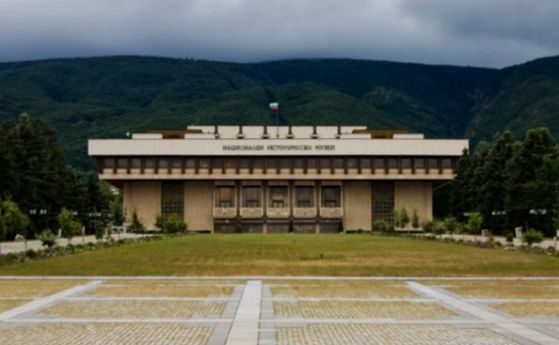The National History Museum in the capital city of Sofia is the largest museum in Bulgaria. Since the year 2000 it is situated in the former residence of the communist government in Bulgaria, at the foothills of Vitosha mountain. The museum is surrounded by a wonderful park with lapidarium, where stone epigraphs, Roman statues, architectural elements and tombstones can be seen.
The building itself has a historical significance for now-a-days Bulgaria, as it is here that the beginning of the transition period started back on 10th of November 1989 after the resignation of the communist leader Todor Zhivkov. The interior is a cubic structure with a lot of woodcarvings, big windows and open space for receptions. In an area of 6000 square meters, there are over 10 000 artefacts that represent the history of Bulgaria (from the VII millennium B.C. until the mid XX century).
The first hall of the exhibition gives an idea of life in Bulgarian lands in the beginning of the VI millennium B.C. until the end of the II millennium B.C. Very impressive are the artefacts from the Varna necropolis, where the oldest man-made golden treasure in the world is found, dating back from the V millennium B.C. Fascinating are the golden necklaces from Dabene from the beginning of the III millennium B.C., made with such precision which amazes even the goldsmiths in present days.
In the second hall there are items from the Bulgarian lands during the end of VI century B.C. until VI century A.D. Undoubtedly, the most interesting are the golden offerings and objects that belonged to the Thracian kings such as a golden wreath and ring – seal which depicts the Great Mother Goddess from the IV c. B.C., found in Zlatinitsa. Very delicate and masterly made is the golden earring from Sinemorets, which depicts the goddess of victory Nike on a chariot drawn by 2 horses. It is believed to have belonged to an eminent Thracian, most probably a priestess. But the masterpiece of the Thracian workmanship is the Panagyurishte golden treasure, dating back from the end of the IV and the beginning of the III century B.C. It consists of a phiale, an amphora and seven rhytons, all made of solid 24-carat gold. All of the objects are richly and skilfully decorated with scenes of Thracian myths, customs and life. The treasure weighs a total of 6.164 kg (13.5 pounds) and is thought to have been used as a royal ceremonial set by the Thracian king Seuthes III. This is arguably the single most valuable set of artifacts ever found on the territory of Bulgaria.
Most of these treasures that can be seen in this hall. They have toured the world-famous museums – in 2015 they were in Louvre, Paris in the exhibition “The Saga of the Thracian Kings Archaeological Discoveries in Bulgaria” and in 2017 they were welcomed in the Bryggens Museum in Bergen, Norway in the expositiion “Legends in gold. Thracian treasures from Bulgaria.”
The third hall represents the greatness of Medieval Bulgaria in VII – XIV century A.D. There is a copy of parts of the famous treasure found in Malaya Pereshtchepina, Ukraine, which was a burial gift for the Bulgarian khan Kubrat. The original of the treasure is kept in the State Hermitage Museum of Sankt Petersburg, Russia. A lot of burial and everyday items from the first and second Bulgarian kingdoms such as luxury glazed and sgraffito pottery, weapons and jewelry can be seen.
Hall 4 tells the story of life in Bulgaria under the Ottoman yoke 1396 – 1878. The exposition is connected with the Bulgarian revival, the fight for political and religious freedom and the secular education. The tour continues into hall 5 with the exposition of the Third Bulgarian kingdom which begins with the re-establishment of the Bulgarian state in 1878 and ends with its proclamation as the People’s republic in 1946. There are over 800 items which represent the building, development and progress of independent Bulgaria. Among them are personal items of the Bulgarian monarchs, documents and weapons used in the Balkan, First and Second World Wars which played a vital role in the development and political course of the country.
If one wants to get to know the traditional Bulgarians, the Ethnography hall represents the Bulgarian national culture, holidays and national dress from the end of the XIX and the beginning of the XX century. Some of the items that the visitor can see are ritual breads, gaily-coloured eggs, well laden tables and colourful national costumes. The traditional Bulgarian dress usually complies with the everyday use in the agriculture and farming activities. What is interesting is that different elements from it give information about the social life of the bearer – age and marital status, clan and place of birth.
In the numismatic hall coins from the Hellenistic era, Roman times and Medieval times can be seen that characterize Bulgaria as a monetary treasury. The Byzantine coins are the most common foreign currency that circulated in the Bulgarian lands in the period VI – XIV c. The Bulgarian Medieval minting began in the end of the XII c., mainly with silver and copper coins with original portrayals and artistic style. Some of the rarest coins that can be seen are: gold coin from the ancient Macedonian city of Fillipi from IV c. B.C.; bronze coin (sestercia) of the Roman emperor Brittanicus (42-55 y.), gold coin (aurelius) of the Roman empress Manlia Scantilla (193), gold coin (solid) of the Byzantine empress Irina (797 – 802 y.)
The gift shop of the National History Museum gives a memorable end to the visit with skillful copies of the treasures and plenty of fascinating books.





